steering wheel Hyundai Accent 2008 Owner's Manual
[x] Cancel search | Manufacturer: HYUNDAI, Model Year: 2008, Model line: Accent, Model: Hyundai Accent 2008Pages: 273, PDF Size: 9.36 MB
Page 54 of 273
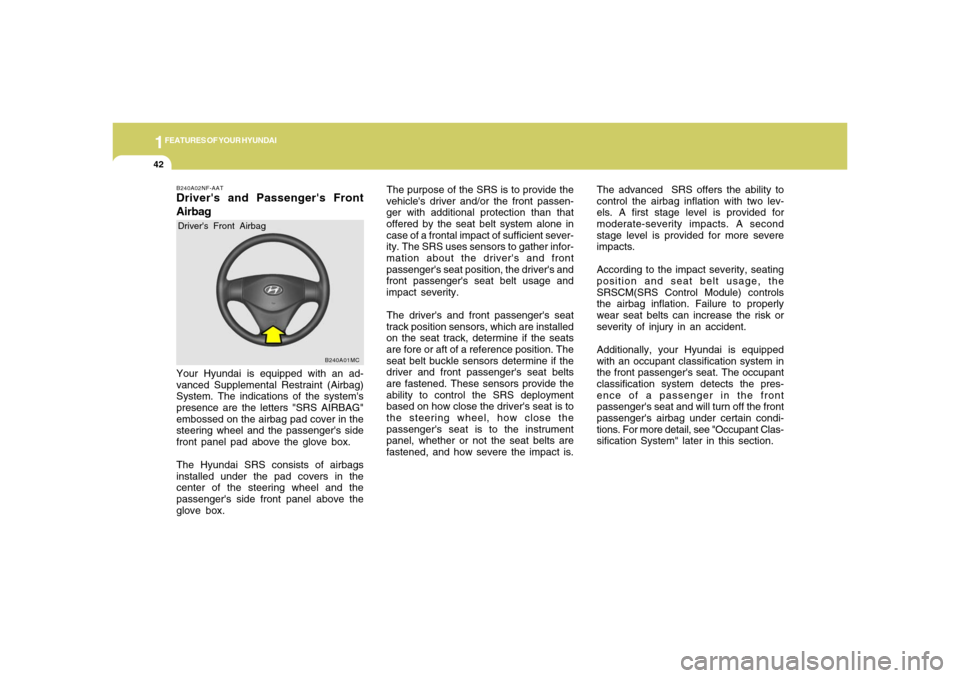
1FEATURES OF YOUR HYUNDAI42
B240A01MC
The purpose of the SRS is to provide the
vehicle's driver and/or the front passen-
ger with additional protection than that
offered by the seat belt system alone in
case of a frontal impact of sufficient sever-
ity. The SRS uses sensors to gather infor-
mation about the driver's and front
passenger's seat position, the driver's and
front passenger's seat belt usage and
impact severity.
The driver's and front passenger's seat
track position sensors, which are installed
on the seat track, determine if the seats
are fore or aft of a reference position. The
seat belt buckle sensors determine if the
driver and front passenger's seat belts
are fastened. These sensors provide the
ability to control the SRS deployment
based on how close the driver's seat is to
the steering wheel, how close the
passenger's seat is to the instrument
panel, whether or not the seat belts are
fastened, and how severe the impact is.The advanced SRS offers the ability to
control the airbag inflation with two lev-
els. A first stage level is provided for
moderate-severity impacts. A second
stage level is provided for more severe
impacts.
According to the impact severity, seating
position and seat belt usage, the
SRSCM(SRS Control Module) controls
the airbag inflation. Failure to properly
wear seat belts can increase the risk or
severity of injury in an accident.
Additionally, your Hyundai is equipped
with an occupant classification system in
the front passenger's seat. The occupant
classification system detects the pres-
ence of a passenger in the front
passenger's seat and will turn off the front
passenger's airbag under certain condi-
tions. For more detail, see "Occupant Clas-
sification System" later in this section.
B240A02NF-AATDriver's and Passenger's Front
AirbagYour Hyundai is equipped with an ad-
vanced Supplemental Restraint (Airbag)
System. The indications of the system's
presence are the letters "SRS AIRBAG"
embossed on the airbag pad cover in the
steering wheel and the passenger's side
front panel pad above the glove box.
The Hyundai SRS consists of airbags
installed under the pad covers in the
center of the steering wheel and the
passenger's side front panel above the
glove box.Driver's Front Airbag
Page 59 of 273
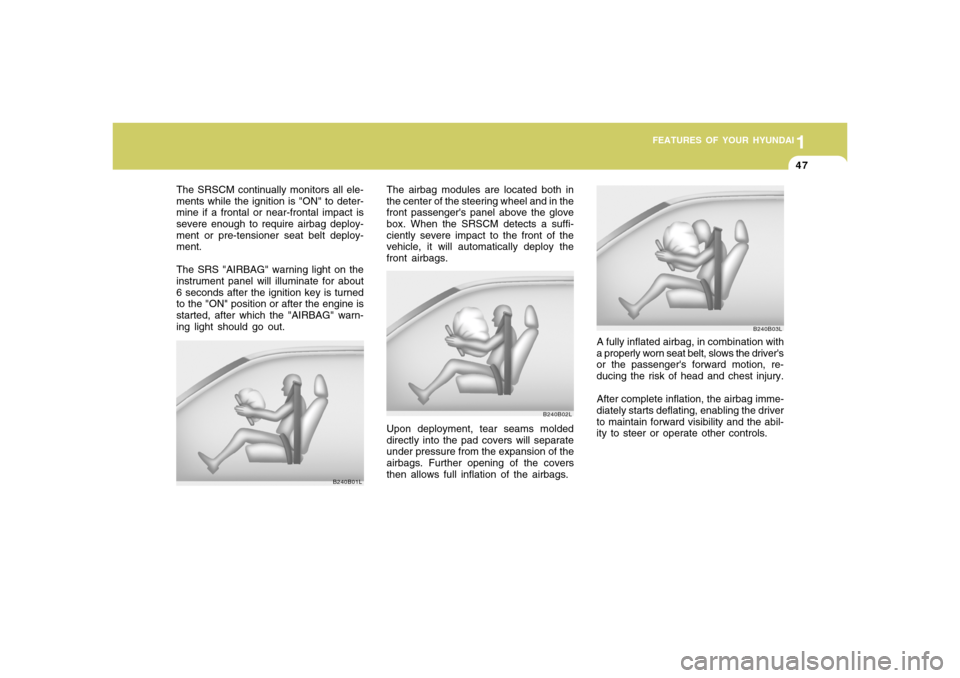
1
FEATURES OF YOUR HYUNDAI
471
FEATURES OF YOUR HYUNDAI
47
The SRSCM continually monitors all ele-
ments while the ignition is "ON" to deter-
mine if a frontal or near-frontal impact is
severe enough to require airbag deploy-
ment or pre-tensioner seat belt deploy-
ment.
The SRS "AIRBAG" warning light on the
instrument panel will illuminate for about
6 seconds after the ignition key is turned
to the "ON" position or after the engine is
started, after which the "AIRBAG" warn-
ing light should go out.
B240B01L
Upon deployment, tear seams molded
directly into the pad covers will separate
under pressure from the expansion of the
airbags. Further opening of the covers
then allows full inflation of the airbags. The airbag modules are located both in
the center of the steering wheel and in the
front passenger's panel above the glove
box. When the SRSCM detects a suffi-
ciently severe impact to the front of the
vehicle, it will automatically deploy the
front airbags.
B240B02L
A fully inflated airbag, in combination with
a properly worn seat belt, slows the driver's
or the passenger's forward motion, re-
ducing the risk of head and chest injury.
After complete inflation, the airbag imme-
diately starts deflating, enabling the driver
to maintain forward visibility and the abil-
ity to steer or operate other controls.
B240B03L
Page 67 of 273
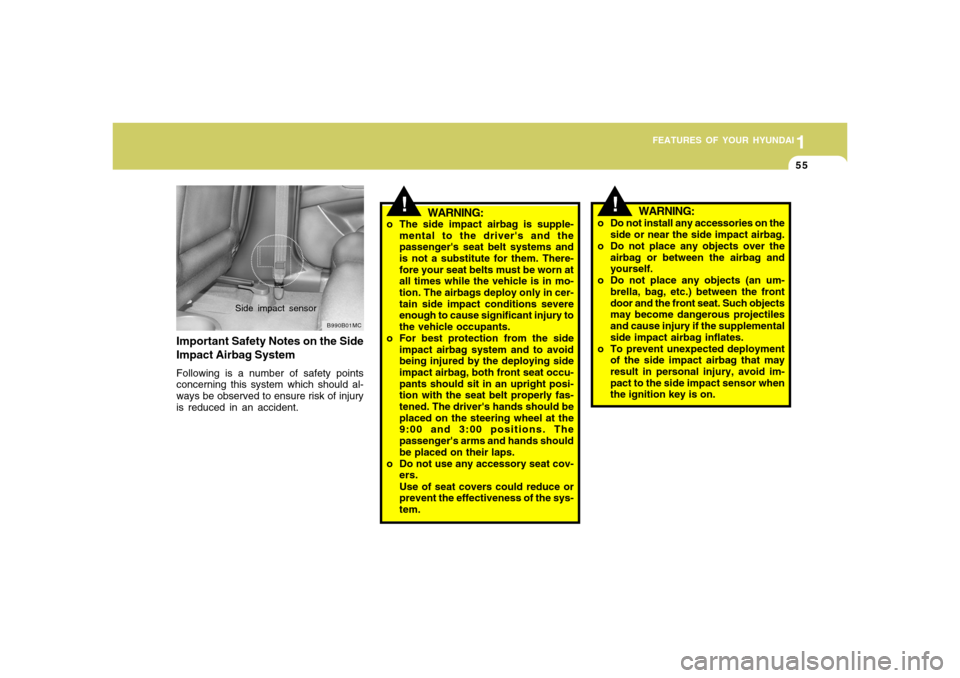
1
FEATURES OF YOUR HYUNDAI
551
FEATURES OF YOUR HYUNDAI
55
WARNING:
o The side impact airbag is supple-
mental to the driver's and the
passenger's seat belt systems and
is not a substitute for them. There-
fore your seat belts must be worn at
all times while the vehicle is in mo-
tion. The airbags deploy only in cer-
tain side impact conditions severe
enough to cause significant injury to
the vehicle occupants.
o For best protection from the side
impact airbag system and to avoid
being injured by the deploying side
impact airbag, both front seat occu-
pants should sit in an upright posi-
tion with the seat belt properly fas-
tened. The driver's hands should be
placed on the steering wheel at the
9:00 and 3:00 positions. The
passenger's arms and hands should
be placed on their laps.
o Do not use any accessory seat cov-
ers.
Use of seat covers could reduce or
prevent the effectiveness of the sys-
tem.
!
B990B01MC
Side impact sensor
Important Safety Notes on the Side
Impact Airbag SystemFollowing is a number of safety points
concerning this system which should al-
ways be observed to ensure risk of injury
is reduced in an accident.
!
o Do not install any accessories on the
side or near the side impact airbag.
o Do not place any objects over the
airbag or between the airbag and
yourself.
o Do not place any objects (an um-
brella, bag, etc.) between the front
door and the front seat. Such objects
may become dangerous projectiles
and cause injury if the supplemental
side impact airbag inflates.
o To prevent unexpected deployment
of the side impact airbag that may
result in personal injury, avoid im-
pact to the side impact sensor when
the ignition key is on.
WARNING:
Page 69 of 273
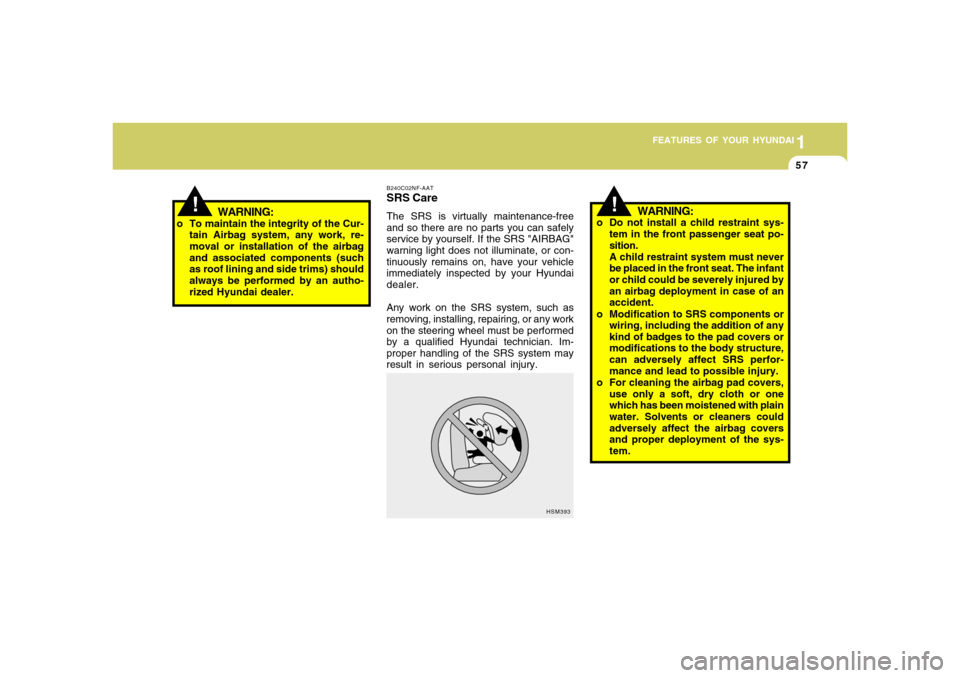
1
FEATURES OF YOUR HYUNDAI
571
FEATURES OF YOUR HYUNDAI
57
B240C02NF-AATSRS CareThe SRS is virtually maintenance-free
and so there are no parts you can safely
service by yourself. If the SRS "AIRBAG"
warning light does not illuminate, or con-
tinuously remains on, have your vehicle
immediately inspected by your Hyundai
dealer.
Any work on the SRS system, such as
removing, installing, repairing, or any work
on the steering wheel must be performed
by a qualified Hyundai technician. Im-
proper handling of the SRS system may
result in serious personal injury.
HSM393
!
WARNING:
o To maintain the integrity of the Cur-
tain Airbag system, any work, re-
moval or installation of the airbag
and associated components (such
as roof lining and side trims) should
always be performed by an autho-
rized Hyundai dealer.
WARNING:
o Do not install a child restraint sys-
tem in the front passenger seat po-
sition.
A child restraint system must never
be placed in the front seat. The infant
or child could be severely injured by
an airbag deployment in case of an
accident.
o Modification to SRS components or
wiring, including the addition of any
kind of badges to the pad covers or
modifications to the body structure,
can adversely affect SRS perfor-
mance and lead to possible injury.
o For cleaning the airbag pad covers,
use only a soft, dry cloth or one
which has been moistened with plain
water. Solvents or cleaners could
adversely affect the airbag covers
and proper deployment of the sys-
tem.
!
Page 80 of 273
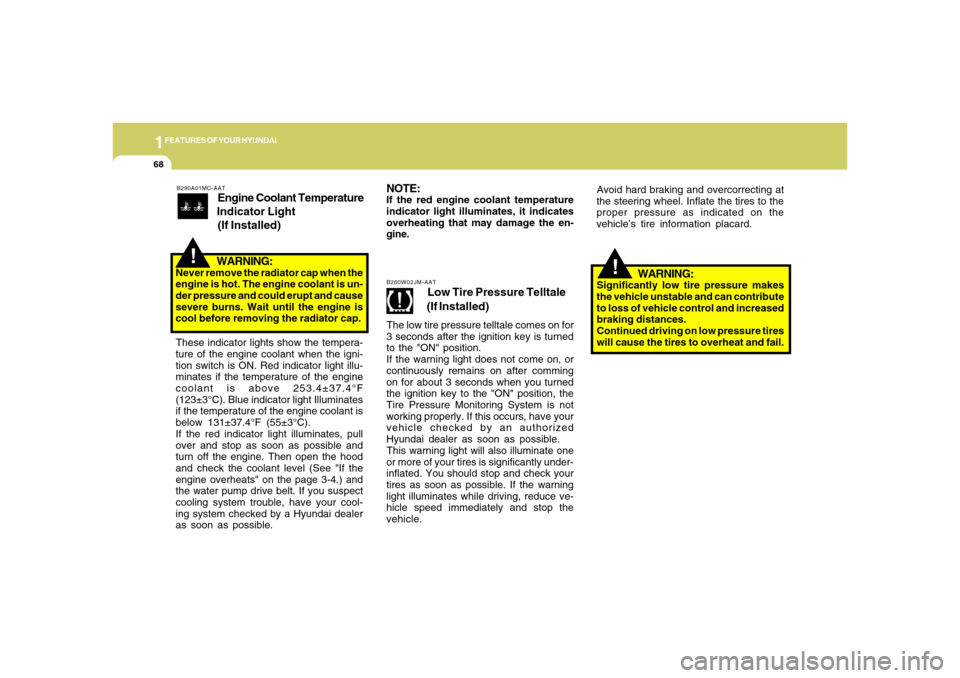
1FEATURES OF YOUR HYUNDAI68
NOTE:If the red engine coolant temperature
indicator light illuminates, it indicates
overheating that may damage the en-
gine.
B290A01MC-AAT
Engine Coolant Temperature
Indicator Light
(If Installed)
WARNING:
Never remove the radiator cap when the
engine is hot. The engine coolant is un-
der pressure and could erupt and cause
severe burns. Wait until the engine is
cool before removing the radiator cap.
!
These indicator lights show the tempera-
ture of the engine coolant when the igni-
tion switch is ON. Red indicator light illu-
minates if the temperature of the engine
coolant is above 253.4±37.4°F
(123±3°C). Blue indicator light Illuminates
if the temperature of the engine coolant is
below 131±37.4°F (55±3°C).
If the red indicator light illuminates, pull
over and stop as soon as possible and
turn off the engine. Then open the hood
and check the coolant level (See "If the
engine overheats" on the page 3-4.) and
the water pump drive belt. If you suspect
cooling system trouble, have your cool-
ing system checked by a Hyundai dealer
as soon as possible.
!
WARNING:
Significantly low tire pressure makes
the vehicle unstable and can contribute
to loss of vehicle control and increased
braking distances.
Continued driving on low pressure tires
will cause the tires to overheat and fail.
B260W02JM-AAT
Low Tire Pressure Telltale
(If Installed)
The low tire pressure telltale comes on for
3 seconds after the ignition key is turned
to the "ON" position.
If the warning light does not come on, or
continuously remains on after comming
on for about 3 seconds when you turned
the ignition key to the "ON" position, the
Tire Pressure Monitoring System is not
working properly. If this occurs, have your
vehicle checked by an authorized
Hyundai dealer as soon as possible.
This warning light will also illuminate one
or more of your tires is significantly under-
inflated. You should stop and check your
tires as soon as possible. If the warning
light illuminates while driving, reduce ve-
hicle speed immediately and stop the
vehicle.
Avoid hard braking and overcorrecting at
the steering wheel. Inflate the tires to the
proper pressure as indicated on the
vehicle’s tire information placard.
Page 91 of 273
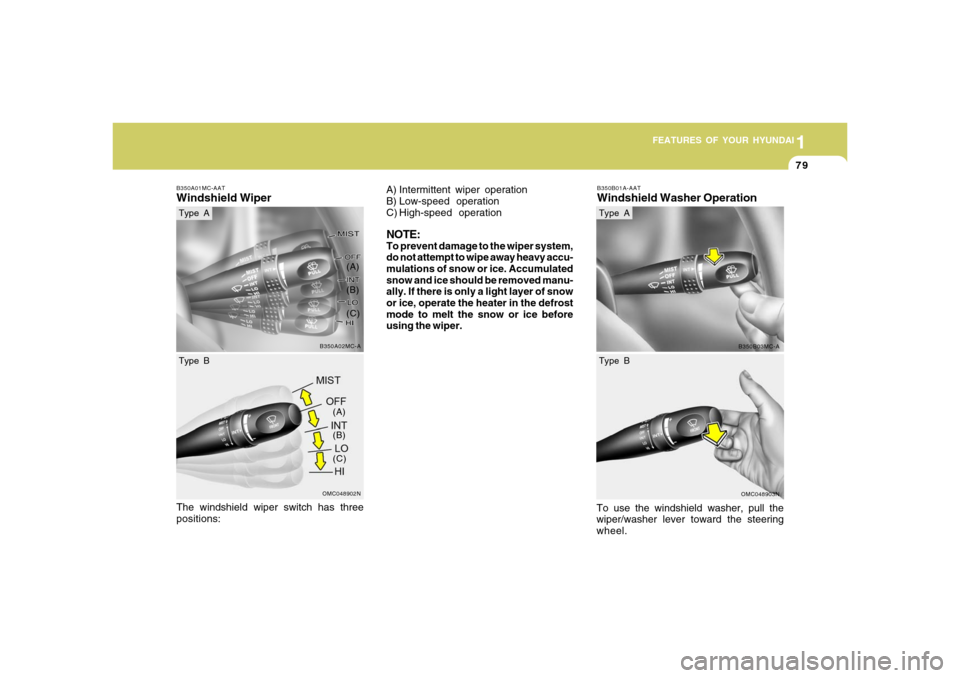
1
FEATURES OF YOUR HYUNDAI
791
FEATURES OF YOUR HYUNDAI
79
B350A01MC-AATWindshield Wiper
A) Intermittent wiper operation
B) Low-speed operation
C) High-speed operationNOTE:To prevent damage to the wiper system,
do not attempt to wipe away heavy accu-
mulations of snow or ice. Accumulated
snow and ice should be removed manu-
ally. If there is only a light layer of snow
or ice, operate the heater in the defrost
mode to melt the snow or ice before
using the wiper.
B350A02MC-A
B350B01A-AATWindshield Washer OperationTo use the windshield washer, pull the
wiper/washer lever toward the steering
wheel.
B350B03MC-A
(A)
(B)
(C)
OMC048902N(A)
(B)
(C)
The windshield wiper switch has three
positions:
OMC048903N
Type B
Type A
Type B
Type A
Page 116 of 273
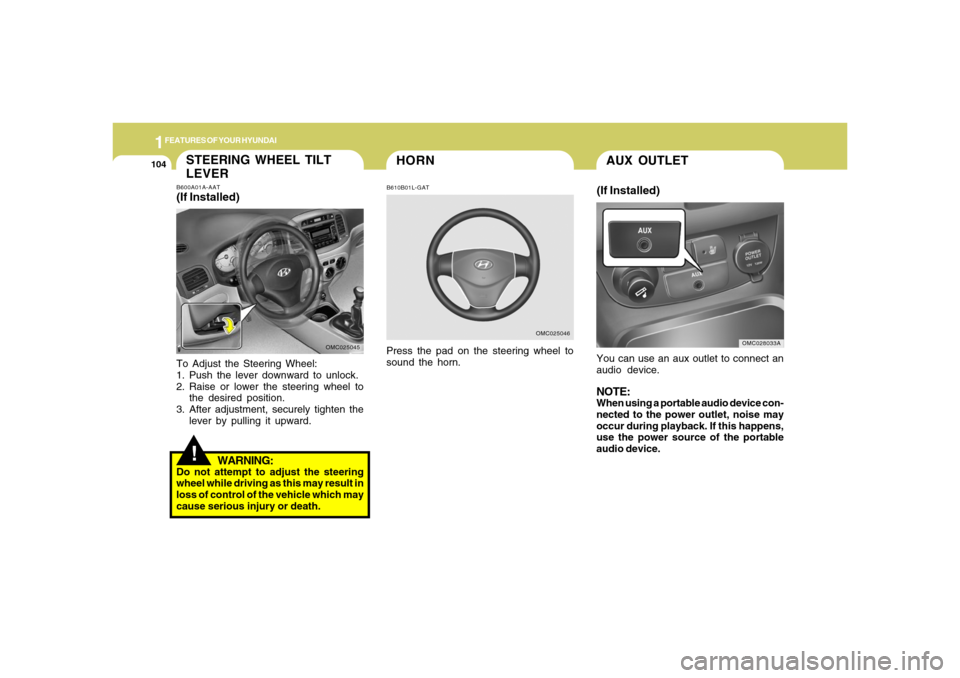
1FEATURES OF YOUR HYUNDAI
104
!STEERING WHEEL TILT
LEVERB600A01A-AAT(If Installed)To Adjust the Steering Wheel:
1. Push the lever downward to unlock.
2. Raise or lower the steering wheel to
the desired position.
3. After adjustment, securely tighten the
lever by pulling it upward.
WARNING:
Do not attempt to adjust the steering
wheel while driving as this may result in
loss of control of the vehicle which may
cause serious injury or death.
OMC025045
HORNB610B01L-GATPress the pad on the steering wheel to
sound the horn.
OMC025046
AUX OUTLET(If Installed)You can use an aux outlet to connect an
audio device.NOTE:When using a portable audio device con-
nected to the power outlet, noise may
occur during playback. If this happens,
use the power source of the portable
audio device.
OMC028033A
Page 151 of 273
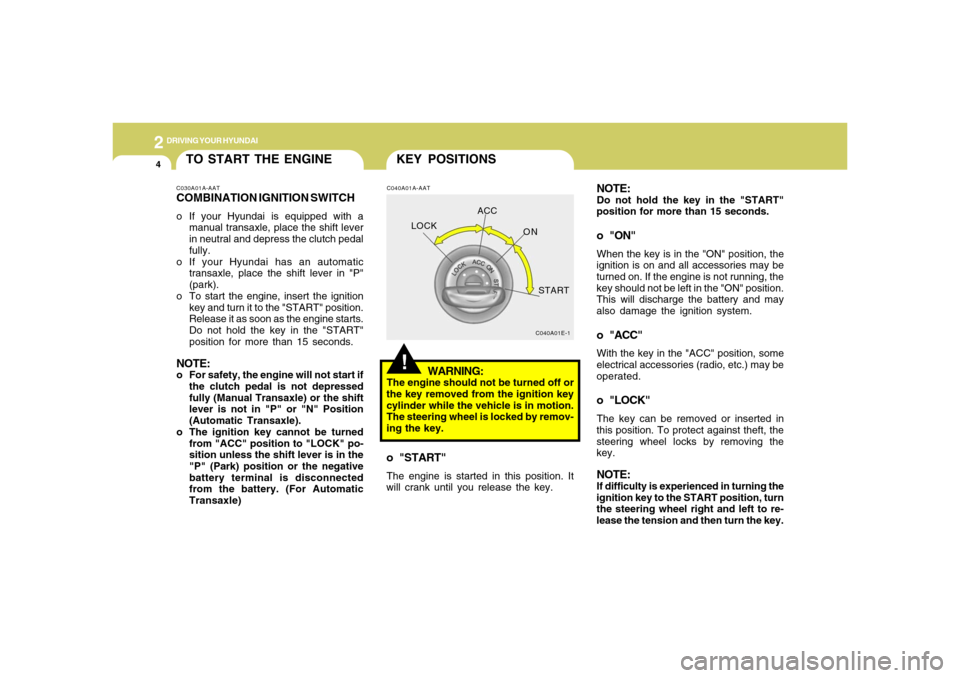
2
DRIVING YOUR HYUNDAI4
C040A01A-AAT
WARNING:
The engine should not be turned off or
the key removed from the ignition key
cylinder while the vehicle is in motion.
The steering wheel is locked by remov-
ing the key.o "START"The engine is started in this position. It
will crank until you release the key.
!KEY POSITIONS
C040A01E-1
LOCKACC
ON
START
NOTE:Do not hold the key in the "START"
position for more than 15 seconds.o "ON"When the key is in the "ON" position, the
ignition is on and all accessories may be
turned on. If the engine is not running, the
key should not be left in the "ON" position.
This will discharge the battery and may
also damage the ignition system.o "ACC"With the key in the "ACC" position, some
electrical accessories (radio, etc.) may be
operated.o "LOCK"The key can be removed or inserted in
this position. To protect against theft, the
steering wheel locks by removing the
key.NOTE:If difficulty is experienced in turning the
ignition key to the START position, turn
the steering wheel right and left to re-
lease the tension and then turn the key.
TO START THE ENGINEC030A01A-AATCOMBINATION IGNITION SWITCHo If your Hyundai is equipped with a
manual transaxle, place the shift lever
in neutral and depress the clutch pedal
fully.
o If your Hyundai has an automatic
transaxle, place the shift lever in "P"
(park).
o To start the engine, insert the ignition
key and turn it to the "START" position.
Release it as soon as the engine starts.
Do not hold the key in the "START"
position for more than 15 seconds.NOTE:o For safety, the engine will not start if
the clutch pedal is not depressed
fully (Manual Transaxle) or the shift
lever is not in "P" or "N" Position
(Automatic Transaxle).
o The ignition key cannot be turned
from "ACC" position to "LOCK" po-
sition unless the shift lever is in the
"P" (Park) position or the negative
battery terminal is disconnected
from the battery. (For Automatic
Transaxle)
Page 155 of 273
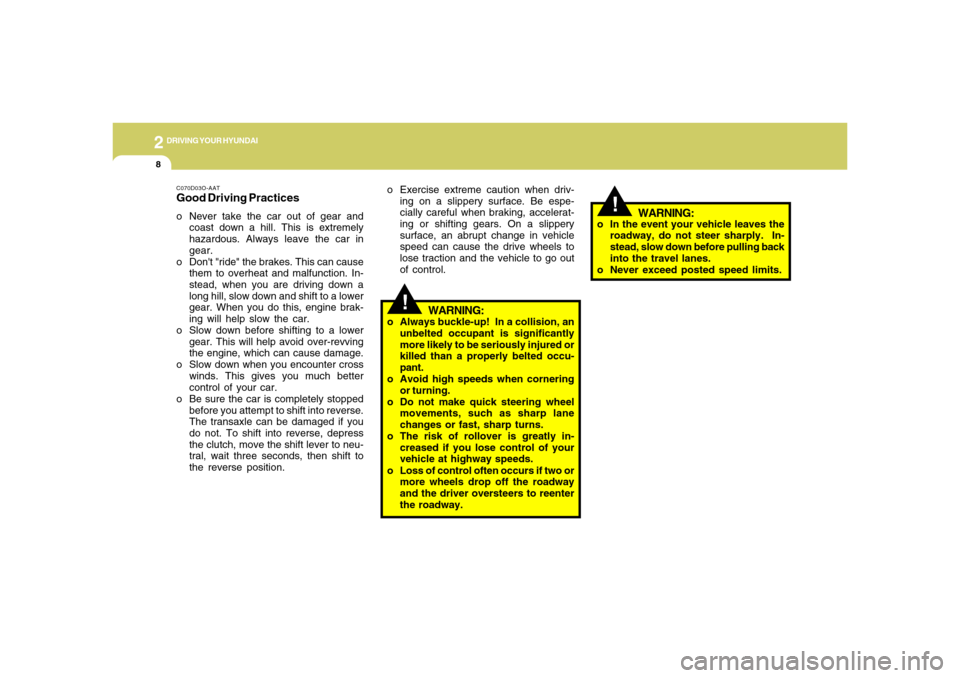
2
DRIVING YOUR HYUNDAI8
!
o In the event your vehicle leaves the
roadway, do not steer sharply. In-
stead, slow down before pulling back
into the travel lanes.
o Never exceed posted speed limits.
WARNING:
!
o Exercise extreme caution when driv-
ing on a slippery surface. Be espe-
cially careful when braking, accelerat-
ing or shifting gears. On a slippery
surface, an abrupt change in vehicle
speed can cause the drive wheels to
lose traction and the vehicle to go out
of control.
WARNING:
o Always buckle-up! In a collision, an
unbelted occupant is significantly
more likely to be seriously injured or
killed than a properly belted occu-
pant.
o Avoid high speeds when cornering
or turning.
o Do not make quick steering wheel
movements, such as sharp lane
changes or fast, sharp turns.
o The risk of rollover is greatly in-
creased if you lose control of your
vehicle at highway speeds.
o Loss of control often occurs if two or
more wheels drop off the roadway
and the driver oversteers to reenter
the roadway.
C070D03O-AATGood Driving Practiceso Never take the car out of gear and
coast down a hill. This is extremely
hazardous. Always leave the car in
gear.
o Don't "ride" the brakes. This can cause
them to overheat and malfunction. In-
stead, when you are driving down a
long hill, slow down and shift to a lower
gear. When you do this, engine brak-
ing will help slow the car.
o Slow down before shifting to a lower
gear. This will help avoid over-revving
the engine, which can cause damage.
o Slow down when you encounter cross
winds. This gives you much better
control of your car.
o Be sure the car is completely stopped
before you attempt to shift into reverse.
The transaxle can be damaged if you
do not. To shift into reverse, depress
the clutch, move the shift lever to neu-
tral, wait three seconds, then shift to
the reverse position.
Page 159 of 273
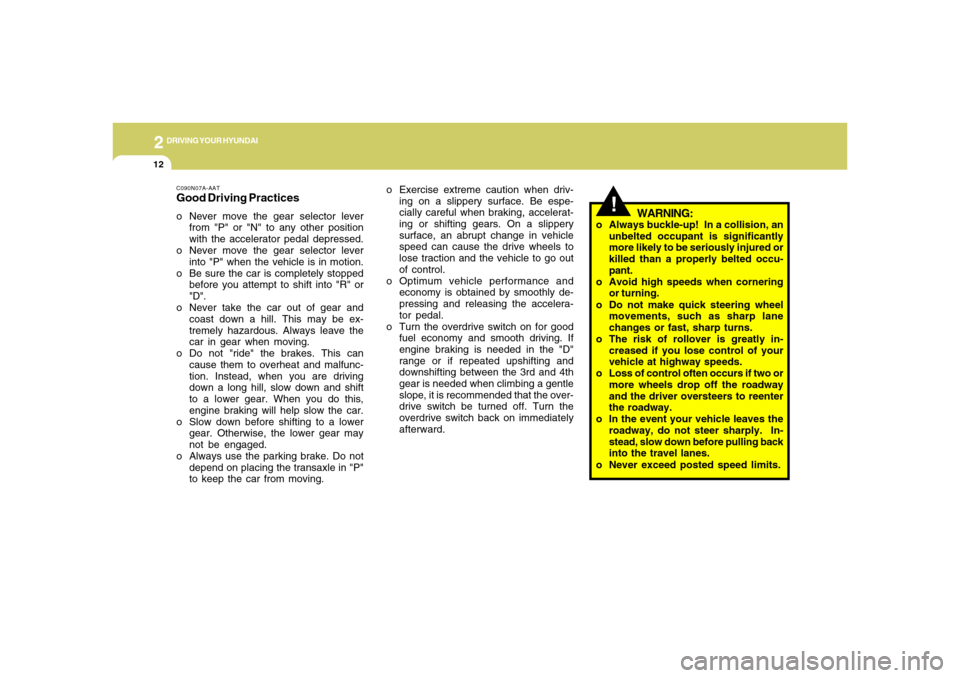
2
DRIVING YOUR HYUNDAI
12
WARNING:
o Always buckle-up! In a collision, an
unbelted occupant is significantly
more likely to be seriously injured or
killed than a properly belted occu-
pant.
o Avoid high speeds when cornering
or turning.
o Do not make quick steering wheel
movements, such as sharp lane
changes or fast, sharp turns.
o The risk of rollover is greatly in-
creased if you lose control of your
vehicle at highway speeds.
o Loss of control often occurs if two or
more wheels drop off the roadway
and the driver oversteers to reenter
the roadway.
o In the event your vehicle leaves the
roadway, do not steer sharply. In-
stead, slow down before pulling back
into the travel lanes.
o Never exceed posted speed limits.
!
o Exercise extreme caution when driv-
ing on a slippery surface. Be espe-
cially careful when braking, accelerat-
ing or shifting gears. On a slippery
surface, an abrupt change in vehicle
speed can cause the drive wheels to
lose traction and the vehicle to go out
of control.
o Optimum vehicle performance and
economy is obtained by smoothly de-
pressing and releasing the accelera-
tor pedal.
o Turn the overdrive switch on for good
fuel economy and smooth driving. If
engine braking is needed in the "D"
range or if repeated upshifting and
downshifting between the 3rd and 4th
gear is needed when climbing a gentle
slope, it is recommended that the over-
drive switch be turned off. Turn the
overdrive switch back on immediately
afterward.
C090N07A-AATGood Driving Practiceso Never move the gear selector lever
from "P" or "N" to any other position
with the accelerator pedal depressed.
o Never move the gear selector lever
into "P" when the vehicle is in motion.
o Be sure the car is completely stopped
before you attempt to shift into "R" or
"D".
o Never take the car out of gear and
coast down a hill. This may be ex-
tremely hazardous. Always leave the
car in gear when moving.
o Do not "ride" the brakes. This can
cause them to overheat and malfunc-
tion. Instead, when you are driving
down a long hill, slow down and shift
to a lower gear. When you do this,
engine braking will help slow the car.
o Slow down before shifting to a lower
gear. Otherwise, the lower gear may
not be engaged.
o Always use the parking brake. Do not
depend on placing the transaxle in "P"
to keep the car from moving.